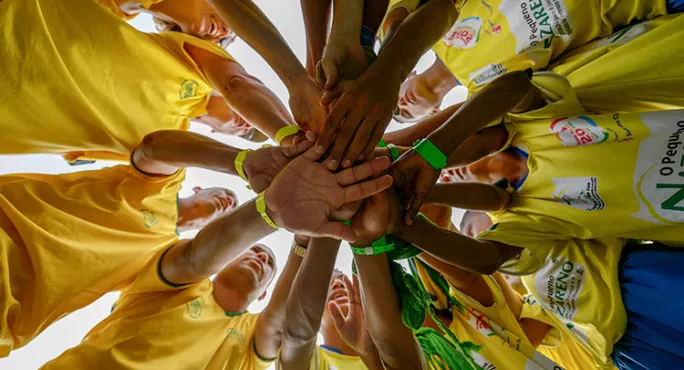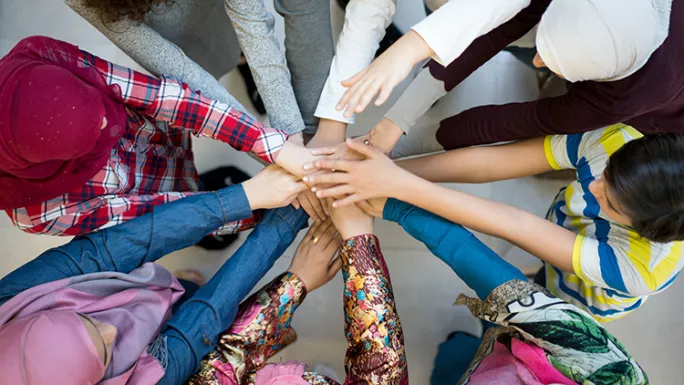- Home
- Want happier pupils? Make your classroom ‘tribal’
Want happier pupils? Make your classroom ‘tribal’

We humans are an innately tribal species. Our survival over hundreds of thousands of years has depended on it. But it’s only in the past 5,000 years that humans have gone from living in tribal societies to industrial-based ones, and that is the blink of an eye in terms of biological evolution.
As such, Professor Louis Cozolino, author of The Social Neuroscience of Education, argues that we are deeply rooted in our tribal past. He believes that teachers who can tap into children’s primitive social instincts by creating "tribal classrooms" can achieve amazing things even in very challenging education settings.
The simple fact is, children feel safest, happiest and actually learn the best when they live and operate as part of a tribe.
Quick read: Four ways you can teach happiness
Quick listen: The truth about mental health in schools
Want to know more? How 'pop-up' safe spaces can improve pupil wellbeing
But how does one actually go about creating a "tribal classroom"?
1. Create a team flag
One way to tap into your class’ tribal instincts is to help them feel part of a team. Why not show them a short video montage of one of the most successful teams around – Team GB. This one is pretty good:
After watching the video, ask your class to think of the values, qualities and attributes Team GB displayed to be so successful (typically children come up with "effort", "honesty", "teamwork", "friendship", etc. You can scribe these on a whiteboard).
Then ask them to choose a value that means something to them, write it in bold on a piece of blank paper and then fill their page with colour.
Piece together all of the children’s sheets to create one large, eye-catching team flag.
The flag shows that your class belong to a team, that they have values they aspire to live up to and that they are part of something bigger than themselves.
2. Greetings
Always ensure that your morning starts with a positive greeting at the door. Studies show that positive greetings can increase attainment, reduce disruptive behaviour and foster a sense of belonging.
Welcome your class with a smile and by saying their name. Not only are smiles contagious (so a quick win for spreading positivity through your tribe) but also using children’s first names is a powerful way of connecting and signals to your team members that they have been noticed and that they matter.
Despite a recent EduTwitter furore over this, you could mix your greetings up with a handshake, high-five or first bump as positive touch is crucial to emotional development and wellbeing. But always be mindful of pupils who do not want to be greeted in this way and allow them to enter class in a way that feels comfortable for them.

3. Endings
How we end our days is important, too. Nobel prize-winner Daniel Kahneman’s work on ‘peak-end’ theory shows that people tend to judge an experience based on the most intense emotional point (the "peak") and its end.
If an ending is positive, people tend to judge the whole experience as positive, even if it was largely neutral or negative. So always aim to end your day on a high (read a great story, play games, have quizzes). And if a day hasn’t been particularly great for one of your tribe in terms of behaviour, remind them of the team flag and let them know that tomorrow is a new day and a fresh start. This allows you to maintain boundaries but in a supportive way.
4. Eat together
Some schools have introduced "family dining" where teachers and support staff are invited to eat their lunch with their classes (most schools do this voluntarily and will even pay for the staff lunch, too). Studies show that children that eat with their families show better mental health and may even get better grades at school. But many of our young people don’t get to benefit from family meals together, which is why tribal classrooms can fill the void. Tribes that eat together, stick together!
5. Get moving out in nature
Our ancestors used to roam for up to 12 miles a day out on the savannah, but our children are leading more sedentary lifestyles than ever before. The chief medical officer for the UK recommends that children take part in a minimum of 60 minutes vigorous activity per day. But a report in 2015 showed that 84 per cent of girls and 79 per cent of boys in England are not meeting this recommendation. So, get your tribe outside and moving. You could introduce the Daily Mile into your school (where children run or jog for 15 minutes everyday outside), or raise money to take your class to an outdoor activity centre with high-rope tree climbing. Not only is exercise essential for good mental and physical health but studies also show that getting out in nature lowers stress and anxiety levels.
Creating tribal classrooms is about tapping into instincts that are at children’s very core. When you create a sense in your classroom that everyone matters, that they belong to a team and that you’re there to support and guide them, not only does it aid their wellbeing but children will also feel ready to take risks, explore and learn.
Adrian Bethune is a primary teacher and the author of Wellbeing in the Primary Classroom
Further reading:
- Science author and broadcaster Kat Arney investigates the "anxiety epidemic" in schools.
- Two tips from kids' books for being happy.
- Book review: Wellbeing in the Primary Classroom
Keep reading for just £1 per month
You've reached your limit of free articles this month. Subscribe for £1 per month for three months and get:
- Unlimited access to all Tes magazine content
- Exclusive subscriber-only stories
- Award-winning email newsletters



